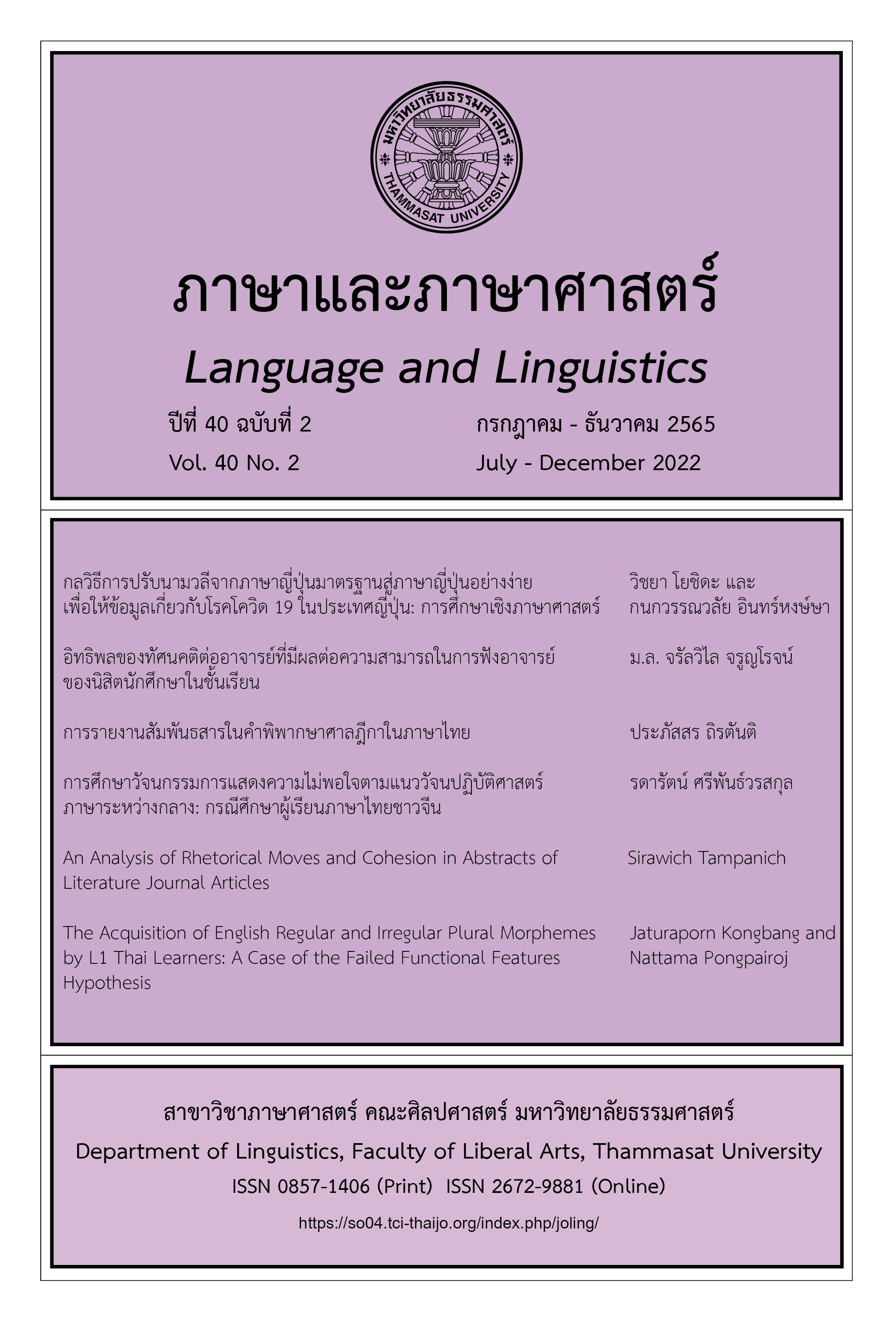Strategies for Converting Noun Phrases from Standard Japanese to Easy Japanese in Order to Provide Information about COVID-19 in Japan: A Linguistic Study
Main Article Content
Abstract
The purpose of this research was to examine linguistic strategies for converting standard Japanese noun phrases into Easy Japanese within the context of providing information about COVID-19. The results of the research showed the following strategies for modifying noun phrases: 1) word change strategies; that is, by changing noun phrases from standard Japanese to Easy Japanese, there are strategies for changing sub-words, such as using words with similar meanings, the use of synonymous meanings, and the use of hyponymy instead of hypernymy, 2) not using compounds of Japanese words and borrowed words, 3) a strategy of reducing politeness, and 4) a strategy of adding an explanation. This can be divided into two cases: Using hiragana characters instead of kanji and expanding the meaning, and adding words written in Roman characters at the end of words. These are linguistic strategies; either semantic, morphological, or syntactic strategies, or verbal tactics. In addition, we found that the prefix o- when used with Easy Japanese words is not used to show politeness, but to make words more aesthetically pleasing. This research also presents information about the use of borrowed words and words written in the Roman alphabet that contradict the principles of Easy Japanese.
Article Details

This work is licensed under a Creative Commons Attribution-NonCommercial-NoDerivatives 4.0 International License.
บทความทุกบทความเป็นลิขสิทธิ์ของภาษาและภาษาศาสตร์
References
กนกวรรณวลัย อินทร์หงษ์ษา. (2562). โครงสร้างการีตในภาษาไทยและภาษาญี่ปุ่น: การศึกษาเปรียบเทียบเชิงวากยสัมพันธ์และระบบคำ. มนุษยศาสตร์สังคมศาสตร์, 36(1), 169-193.
ทรงธรรม อินทจักร. (2550). แนวคิดพื้นฐานด้านวัจนปฏิบัติศาสตร์. สำนักพิมพ์มหาวิทยาลัยธรรมศาสตร์.
ประกาศกระทรวงสาธารณสุข เรื่อง ชื่อและอาการสำคัญของโรคติดต่ออันตราย (ฉบับที่ 3). (29 กุมภาพันธ์ 2563). ราชกิจจานุเบกษา. เล่ม 137 ตอนพิเศษ 48ง หน้า 1.
วิชยา โยชิดะ. (2562). การส่งแรงงานชาวอีสานสู่ประเทศญี่ปุ่นภายใต้นโยบายใหม่. โครงการจัดประชุมวิชาการระดับชาติเวทีวิจัยมนุษยศาสตร์ไทย ครั้งที่ 13: ภูมิภาคนิยมและท้องถิ่นนิยมสมัยใหม่ ในโลกไร้พรมแดน (น. 106-122). คณะมนุษยศาสตร์และสังคมศาสตร์ มหาวิทยาลัยมหาสารคามร่วมกับสำนักงานคณะกรรมการส่งเสริมวิทยาศาสตร์ วิจัยและนวัตกรรม (สกสว.).
วิภาส โพธิแพทย์. (2561). ภาษาไทยในมุมมองแบบลักษณ์ภาษา. โครงการเผยแพร่ผลงานวิชาการคณะอักษรศาสตร์ จุฬาลงกรณ์มหาวิทยาลัย.
Agency for Cultural Affairs. (2020). Easy Japanese guidelines for residence support. https://www.bunka.go.jp/seisaku/kokugo_nihongo/kyoiku/92484001.html
Arai, T. (2020, April 2). Kabushikikaisha RSVIPA wa shigatu tuitachi yori kazen rimootowaaku terewaaku (zaitakukimu) wo kaishiitashimashita. https://www.excite.co.jp/news/article/Prtimes_2020-04-02-54365-52/
Carnie, A. (2013). Syntax: A generative introduction (3th ed.). Wiley-Blackwell.
Cook, V. J., & Newson, M. (2007). Chomsky’s universal grammar: An introduction. Blackwell.
Grice, H. P. (1975). Logic and conversation. In P. Cole & J. Morgan (Eds.), Syntax and semantics 3: Speech act (pp. 41-58). Academic Press.
Hasegawa, Y. (2015). Japanese: A linguistics introduction. Cambridge University Press.
Immigration Services Agency of Japan. (2020). https://www.moj.go.jp/isa/other_languages.html
Iori, I. (2016). “Yasashii Nihongo- tabunkakyoseishakai e”. Iwanamishinsho.
Ishihara, S. (2019, Octobor 31). “Yasashii Nihongo wa Shakaigensouni – Tabunkakyoseisyasai no jikgen ni”. http://www.nihongoplat.org/2019/10/31/
Iwata. K. (2020). Iryo de mochiiru “Yasashi Nihongo” Shingata Corona Virusu Kensahen. https://www.youtube.com/watch?v=nwne978lJBc
Japan Telework Association. (n.d.). Telewaaku to wa. https://japan-telework.or.jp/tw_about/?fbclid=IwAR18ZxUxUmuMu1Et0Q8hk9zpfBKEb-x7ei-gIC5Lj3NEI_aM9Gn7KRhszR8
Kuroda, K., Yokono, H., Abe, K., Tsuchiya, T., Asao, Y., Kobayashi, Y., Tagawa, T. (2018). Development of acceptability rating data for Japanese (ARDJ): An initial report. Proc. Of the 24th Annual Meeting of the Association for NLP (pp. 65-68). https://www.anlp.jp/proceedings/annual_meeting/2018/pdf_dir/C1-6.pdf
Lakoff, R. (1973). The logic of politeness: Or, minding your P’s and q’s. In C. Corum, T. C., Smith-Stark, & A. Weiser (Eds.), Papers from 9th Regional Meeting of the Chicago Linguistic Society (pp. 292-305). Chicago Linguistic Society.
Löbner, S. (2013). Understanding semantics. Routledge.
Ministry of Health, Labour and Welfare. (2021). Novel Coronavirus (COVID-19). https://www.mhlw.go.jp/stf/seisakunitsuite/bunya/0000164708_00079.html
Radfor, A. (2004). English syntax: An introdution. Cambridge University Press.
Sato, H. (2013). "Easy Japanese" Sakusei no tame no Guido line. Faculty of Humanities Sociolinguistics Laboratory Hirosaki University. https://www.fdma.go.jp/singi_kento/kento/items/kento207_20_sankou5-6.pdf
Shibata, M. (2006). Yasashii Nihongo no Kokoromi. The NHK Monthly Report on Broadcast Research, 56(2), 36-42. The NHK Broadcasting Culture Research Institute.
Takeda, Y., & Iwata, K. (2019). Yasashii Nihongo o mochiita gaikokujin Shinryo. Japan Medical Association Journal, 49, 10-11.
Tsujimura, N. (2014). An introduction to Japanese linguistics. Wiley Blackwell.
Ueki, Y. (2019). Gaikokujin e no Jyouhoudentatsu no Kagi “Yasashii Nihongo” Hirogaru. The Sankei News. https://www.sankei.com/article/20190122-PLWYR6IFWBP7XGRBKX54D4W5SM/
WHO. (2021, May 26). WHO Coronavirus (COVID-19) dashboard. World Health Organization. https://covid19.who.int/
William, E. (1981). On the notions ‘lexically related’ and ‘head of word’. Linguistic Inquiry, 12(2), 45-74.
Yuasa, C. (2014). "Yasashii Nihongo"ni miru iigaesousaku: gokukoutai no keishikini cyakumokushite, Kanagawa University International Management Review, 48, 145-155.


